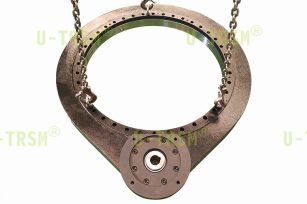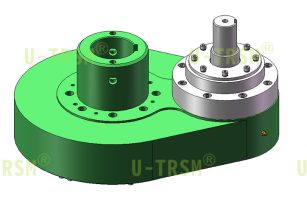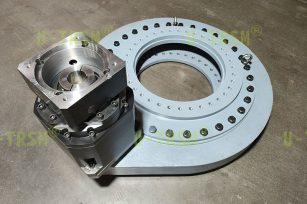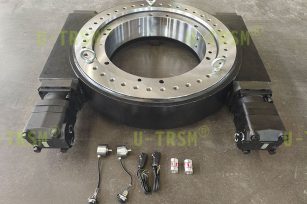Latest Products
We keep on updating and iterating our products, optimizing the structural design and creating a more scientific and reliable slewing drive device.
-
 Selection and characteristics of slewing d...
Selection and characteristics of slewing d...This slewing drive is used in automated mixing equipment. The customer requires that it rotate in the same direction ...
Detailed instructions Send mail -
 Analysis of the high speed rotating double...
Analysis of the high speed rotating double...This double row ball gear type slew drive is used in automation equipment. The customer requires ultra-high speed ope...
Detailed instructions Send mail -
 30855 slew drive assembly: precise protect...
30855 slew drive assembly: precise protect...Introduction In the field of industrial transmission, U-TRSM has always been a leader in innovation, committed...
Detailed instructions Send mail -
 High load slewing drive solution for deep ...
High load slewing drive solution for deep ...This slewing drive is used in marine machinery and equipment, suitable for underwater locations at depths of up to 30...
Detailed instructions Send mail
Reason analysis and solutions for the problems of slewing bearing in use
Publish time:2021/07/05 News Views:815
Question 1: The slewing bearing does not operate flexibly and smoothly
Reason analysis and solutions
Check the production date of the slewing bearing, if it has not been used for a long time and the temperature is low, it may be that the grease in the raceway becomes more viscous, causing inflexible rotation. At this time, you can try to run it for a few laps to see if it can operate normally. If it still does not operate normally, you need to replace the grease. After the grease is replaced, if it can operate normally without other abnormalities, the slewing ring can be used normally.

Question 2: Abnormal noise after installation of slewing bearing
Reason analysis and solutions
Check whether the installation surface is flat enough, loosen the installation bolts and use feeler gauges to check whether there are gaps between the installation surface of the slewing bearing and the plane of the installation foundation. If there are large gaps, it mean that the installation foundation surface is not flat. You need to find suitable thickness gaskets to flat the gaps, then tighten mounting bolts to check whether the abnormal sound is eliminated.
Check whether there is enough grease in the slewing ring. If the grease is not enough, add enough grease. It is usually recommended to add 2# lithium grease. After the grease is added, check whether the abnormal sound is eliminated.
Remove the sealing rings of the slewing rings and check whether there are any foreign bodies in the raceway. If there are foreign bodies, carefully remove the foreign bodies. After removing the foreign bodies, check whether the abnormal sound is eliminated.
Remove the slewing bearing plugs and check whether there are any sharp edges at the position where the bearing plugs are in contact with the raceway. If there are any sharp edges or burrs, use angle grinders to remove the sharp edges and burrs.
Question 3: The slewing bearing has a feeling of tilting and shaking after installation
Reason analysis and solutions
Check whether the mounting holes match with the mounting bolts, if they do not match, replace the bolts immediately. Check whether the bolts are fastened and check whether the bolts are fastened in turn according to the diagonal principle. Check to make sure that a bolt is marked with a marker on the bolt until all bolts are checked and marked. If the bolts are found to be loose, immediately tighten the bolts according to the required tightening torque and mark them.
Use dial indicators to check the clearance of the slewing bearing, eliminate the tilting and shaking caused by the excessive clearance, check whether the frame itself is tilting or shaking. If the frame is shaking, it means that the frame itself is not strong enough and needs to be reinforced or replaced, otherwise it will affect the safety of the whole machine.
Question 4: Teeth broken, teeth loss
Reason analysis and solutions
The tooth backlash between the slewing ring and the gears are inappropriate. Use feeler gauges to check the tooth backlash between the tooth height of the slewing ring and the pinion. The normal tooth backlash should be 0.03* module— 0.04* module. If it is larger or smaller than this range, it will be unfavorable to the rotation of the tooth. Too small tooth backlash will cause a large tooth radial force, resulting in too fast tooth wear, fracture or tooth loss; even too large tooth backlash will cause serious tooth collisions when the equipment is frequently started and stopped or frequently reversed, causing tooth fracture .
The teeth of the slewing ring are not parallel to the teeth of the pinion after installation or use. Clean and wipe the oil stains on the teeth of the slewing ring and pinion, check the tooth contact marks on the tooth surface of the slewing ring and pinion. Normal tooth meshing should be in full contact or most contact in the height direction of the tooth surface. If there is partial contact, it means that the axes of the teeth are not parallel. It is usually necessary to check whether the gear connecting shaft is bent or the pinion connecting bolts are loose, causing the gear to tilt or rotate abnormally. If there is no problem with the gear, check whether the slewing bearing mounting bolts are tight.
Unique Transmission explained 4 common problems and solutions in the process of reusing slewing bearings. Of course, slewing bearings often have more problems than these 4 types. Users will also meet some other problems. Unique Transmission will explain them in detail in the following articles, so please focus on it!
- Introduction to the correct installation m...
- Force rational design of integrated slewin...
- The correct selection can increase the ser...
- Introduction to several common worm types ...
- How to correctly choose bolts for installi...
- How often do you add grease to the slewing...
- Arrangement method of bolts when mounting ...
- What are the advantages of using planetary...










